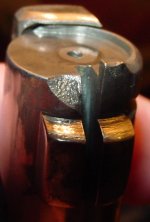7mm Rem Mag Catastrophe
About 20 years ago I did a bad thing. I accidentally put an 8mm cartridge in a 7mm Rem Mag Mauser and pulled the trigger. The bullet made it out of the barrel.
Fortunately God, the gas relief hole on the receiver, and eye and ear protection saved me from anything but a stinging face and arms. After a serious sit-down with myself on stupid procedures I corrected the problem of having two guns (and calibers) on the bench at the same time and put that particular gun away until this morning. I still have all of the metal parts. What's left of the stock is hanging on my office wall as a constant reminder to concentrate. No amount of flames can beat me up worse than I already have folks. Now...
1. How many gunsmiths can MagnaFlux the receiver and bolt to see if they are still viable? Will I have to find an industrial machine shop to do it? The barrel is a massive varmint version, not a hunter.
2. I can't tell any difference in the lugs but don't have a good way to check the front lug engagement areas in the receiver. So if I get a good headspace are the lugs ok assuming the MagnaFlux results on the bolt are good?
I've bought the Jerry Kuhnhausen's Mauser shop manual but before I start into it this afternoon I thought a forum question or two would be a good thing to do.
About 20 years ago I did a bad thing. I accidentally put an 8mm cartridge in a 7mm Rem Mag Mauser and pulled the trigger. The bullet made it out of the barrel.
Fortunately God, the gas relief hole on the receiver, and eye and ear protection saved me from anything but a stinging face and arms. After a serious sit-down with myself on stupid procedures I corrected the problem of having two guns (and calibers) on the bench at the same time and put that particular gun away until this morning. I still have all of the metal parts. What's left of the stock is hanging on my office wall as a constant reminder to concentrate. No amount of flames can beat me up worse than I already have folks. Now...
1. How many gunsmiths can MagnaFlux the receiver and bolt to see if they are still viable? Will I have to find an industrial machine shop to do it? The barrel is a massive varmint version, not a hunter.
2. I can't tell any difference in the lugs but don't have a good way to check the front lug engagement areas in the receiver. So if I get a good headspace are the lugs ok assuming the MagnaFlux results on the bolt are good?
I've bought the Jerry Kuhnhausen's Mauser shop manual but before I start into it this afternoon I thought a forum question or two would be a good thing to do.
Last edited:

